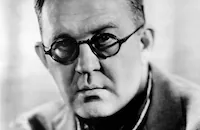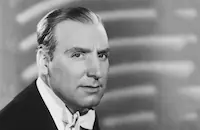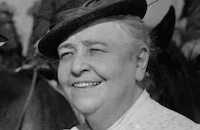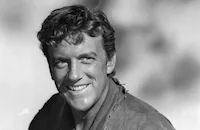Wagon Master

Brief Synopsis
Cast & Crew
John Ford
Ben Johnson
Joanne Dru
Harry Carey Jr.
Ward Bond
Charles Kemper
Film Details
Technical Specs

Synopsis
In the mid-1800s, horse traders Travis Blue and Sandy Owens lead a herd of horses they have captured into the southwestern town of Crystal City, hoping to sell the animals for a good profit. After talking the town's unsuspecting marshal into buying one of their wild horses, Travis and Sandy are approached by two Mormons, the irreverent Jonathan Wiggs and the pious Adam Perkins. Upon learning that the traders are familiar with the region, Wiggs tries to hire them as wagon masters for his small band of Mormon settlers, who are headed for the San Juan Valley in Utah. Anxious to gamble in town, the men at first decline the offer, but later change their minds and join the Mormons, who have been forced to leave Crystal City because of their religion. Not far into the desert, the Mormon group comes across a troupe of stranded medicine show performers, who ran out of water after being driven out of Crystal City and have been drinking their own "elixir" for three days. Although Adam disapproves of the intoxicated troupe--leader Dr. A. Locksley Hall and assistants Floretty "Florey" Phyffe, Mr. Peachtree and young, pretty Denver--Wiggs sympathizes with their plight. Describing their chance meeting with the California-bound troupe as an act of God, Wiggs persuades Adam to allow the performers to ride along with the group. As the emigrants push farther into the desert, their water supplies begin to dwindle, and Travis orders everyone, including the feisty Denver, to conserve. Finally, however, Sandy locates a river, and the thirsty group rushes for relief. That night, a dance is held in camp, giving Travis a chance to romance Denver, while Sandy woos Adam's daughter Prudence. The festivities are interrupted by the arrival of the Clegg family, five fugitive outlaws led by coldblooded killer Uncle Shiloh. Although the smooth-talking Shiloh, who was shot in the shoulder during a murderous holdup, claims that he and his "boys"--brothers Luke, Reese, Jesse and Floyd-- are cowboys, Travis, Sandy and Wiggs know their true identity. To protect the group, however, Travis, Sandy and Wiggs decide to allow the outlaws to travel with them. When Shiloh learns that there is a "doctor" in the group, he orders Hall at gunpoint to remove the bullet from his shoulder. Later, while searching for an alternate route, Travis is pursued by a band of Navajo braves. The Indians chase Travis back to the group, but upon learning that the emigrants are Mormon, their chief invites them all to their camp that night. During the "squaw dance," an Indian woman accuses Reese of attacking her, and Wiggs immediately orders the outlaw to be flogged by his followers. Although Shiloh resents the punishment, he permits it to go on to avoid trouble. Soon after, at the California cutoff, the medicine show troupe says goodbye to the Mormons. Before they get very far, however, Travis proposes to Denver, but is rejected. The troupe's wagon is then stopped by Shiloh, who orders them at gunpoint to return to the wagon train, where they can be watched. Determined to avoid capture by the marshal's posse, Shiloh announces to the entire wagon train that he and his boys will continue on with them until they reach the San Juan Valley. As anticipated, the marshal and his posse come to question the train, and the outlaws hide in various wagons, holding guns to the backs of the Mormons until the posse leaves. That night, Wiggs, Sandy and Travis discuss the final leg of their journey, which involves traversing steep, rocky terrain. Sandy, who has gotten a gun from Prudence's young brother, then argues with Travis about dealing with the outlaws, but the gun-shy Travis declines to act until the Mormons are safely delivered. The next day, the men dig a fresh trail over the rocks, and all of the wagons except the heavy grain wagon make the crossing. To avenge Reese's flogging, Shiloh, who has overheard Wiggs say that their grain is "more valuable than gold," orders the elder to drive the grain wagon, whose horses Floyd intends to scare into a deadly run. Before Floyd carries out his orders, however, Sandy draws his gun and shoots him. Travis shoots and kills the remaining brothers, then outdraws the sneaky Shiloh. With their enemies dead, the Mormons continue to the beautiful San Juan Valley, where Sandy finally kisses Prudence, and Travis reunites with Denver.

Director

John Ford
Cast

Ben Johnson

Joanne Dru

Harry Carey Jr.

Ward Bond

Charles Kemper

Alan Mowbray

Jane Darwell
Ruth Clifford
Russell Simpson
Kathleen O'malley

James Arness
Fred Libby
Mickey Simpson
Hank Worden
Francis Ford
Jim Thorpe
Cliff Lyons
Don Summers
Movita Castañeda

Dickie Moore
Crew
James Basevi
Jack Caffee
Don Cash
Merian C. Cooper
Lowell Farrell
John Ford
Patrick Ford
Bert Glennon
Jack Golconda
Richard Hageman
D. R. O. Hatswell
Wes Jeffries
Stan Jones
Joe Kish
Anna Malin
Jack Murray
Frank Nugent
Adele Parmenter
Clem Portman
Wingate Smith
Archie Stout
Frank Webster

Photo Collections
Videos
Movie Clip




Film Details
Technical Specs

Articles
Wagon Master
In a rare starring role, Ward Bond plays the leader of a group of Mormons who, shunned by society, struggle to cross the American West to reach their "promised land," where they can settle and form a community. They ask two horse traders (Ben Johnson and Harry Carey, Jr.) who know the territory to lead their wagon train. It takes some convincing, but they finally agree to do it, and the rest of the story follows their journey and the obstacles they must overcome, including Indians, gunmen, and Mother Nature. Yet the story often pauses to revel in the characters dancing, whittling or singing (the soundtrack is packed with old Western songs), and to show pastoral sequences of the wagons simply moving through the landscape or crossing a river. These scenes become the emotional core of the film, and they undoubtedly are what Ford was so satisfied to have achieved.
By all accounts, the production of Wagon Master was as relaxed and enjoyable as the movie itself. Fittingly, it was a family project: John Ford received story credit and directed. His son Patrick shared screenplay credit (with Frank Nugent). His brother Francis was in the cast (as Mr. Peachtree), and his daughter Barbara was assistant editor! With a budget just under $1 million (the highest paid actor was Ward Bond at $20,000), Ford was able to shoot the picture in under a month by filming between 10 and 28 setups a day, often doing just one take. Filming took place mostly near Moab, Utah, then a tiny town. On weekends, with nothing else to do, the movie company took over the town theater and put on Robert Service's "The Shooting of Dan McGrew," staged and narrated by John Ireland, who was in Moab to be with his wife Joanne Dru - the leading lady of Wagon Master.
Ford liked Moab because of its landscape - especially its river crossings - but also because of the look of the local populace. Patrick Ford remembered, "Moab had the greatest faces in the world. [John] wouldn't credit a Hollywood extra if he could do otherwise. He wouldn't use a Hollywood Indian if there was still a real Indian alive." Furthermore, wrote Harry Carey, Jr., in his memoir, Company of Heroes, "To [Ford], there was no such person as an extra, and because of that, they all adored him. He knew most of them by name by the end of that first day. They'd do anything for him."
Ward Bond gave one of his most endearing performances in Wagon Master. At one point he accidentally fell off his horse, luckily not hurting his left leg, which had been damaged some time earlier in a car accident and on which he often wore a brace. With the camera still rolling, Bond remained in character, got up and angrily berated the horse - a bit that remained in the picture.
An even more amusing incident happened on the day that Ford decided to work into the film two local dogs who were constantly getting into fights with each other. Ford wanted to stage a fistfight between Carey and a stuntman with the dogs fighting in the background. Ward Bond was then to enter the frame and separate the two men. Ford methodically explained the logistics to everyone, and the two men started their fight. But when the dogs were let loose, they didn't fight - they froze. Then one ran away while the other attacked Bond, ripping his left pant leg wide open. "I have never in my life seen Jack Ford laugh so hard," remembered Carey. "Ward ran into the scene, torn pants and all, and separated the two of us." This scene remains in the finished film.
Producer: Merian C. Cooper, Lowell J. Farrell, John Ford
Director: John Ford
Screenplay: John Ford (story), Patrick Ford, Frank S. Nugent
Cinematography: Bert Glennon
Film Editing: Jack Murray
Art Direction: James Basevi
Music: Richard Hageman, Stan Jones
Cast: Ben Johnson (Travis Blue), Joanne Dru (Denver), Harry Carey Jr. (Sandy), Ward Bond (Elder Wiggs), Charles Kemper (Uncle Shiloh Clegg), Alan Mowbray (Dr. A. Locksley Hall).
BW-86m. Closed captioning.
by Jeremy Arnold

Wagon Master
Quotes
You boys ever draw on anybody?- Uncle Shiloh Clegg
No, sir. Just snakes.- Travis Blue
I thought you never drew on a man?- Elder Wiggs
That's right, sir. Only on snakes.- Travis Blue
Trivia
Notes
Many sources list this film's title as Wagonmaster, although it appears as two words in the onscreen credits. Many sources list the song "Shadows in the Dust" as either "Rollin' in the Dust" or "Rollin' Shadows in the Dust." In addition to the above listed songs, excerpts from the hymn "Come, Come All Ye Saints" are heard in the film. According to Hollywood Reporter news items, most of the picture was shot in eastern Utah. Early location shooting was done in Monument Valley, thirty-two miles northeast of Moab, UT, where the Wagon Master company was based. Other exteriors were filmed at the headwaters of the Colorado River. (Modern sources list Fisher Canyon, north of Professor Valley, and Spanish Valley as additional, specific location sites.) Hollywood Reporter notes that seventy-five "locals" acted as extras. Although Hollywood Reporter reported in late December 1949 that Argosy and RKO were negotiating a new "multiple picture distribution deal," Wagon Master was the last Argosy production to be released by RKO.
According to modern sources, director John Ford wrote the original story for the picture. In a modern interview, Ford said of the film: "Wagon Master came closest to what I had hoped to achieve." Despite Ford's enthusiasm, the picture received mixed reactions from the critics and was not as successful as his "cavalry trilogy," which was released around the same time ( for Fort Apache). According to modern sources, the film lost $65,000 at the box office. Modern sources credit Ford's daughter, Barbara Ford, as assistant editor and Cliff Lyons, who appears in the film as the marshal, as second unit director. In addition, modern sources add Chuck Hayward to the cast. The television series Wagon Train, which aired from 1957 to 1965 on the ABC network and featured Ward Bond as a wagon master, was very loosely based on Wagon Master. After Bond died in 1961, John McIntire took over his role. Ford directed one episode of the popular series entitled "The Colter Craven Story."

Miscellaneous Notes
Released in United States March 1976
Released in United States on Video September 12, 1990
Released in United States Spring April 22, 1950
Broadcast over TNT (colorized version) September 7, 12 & 28, 1990.
Released in United States March 1976 (Shown at FILMEX: Los Angeles International Film Exposition (The 48-Hour Cowboy Movie Marathon) March 18-31, 1976.)
Released in United States Spring April 22, 1950
Released in United States on Video September 12, 1990













